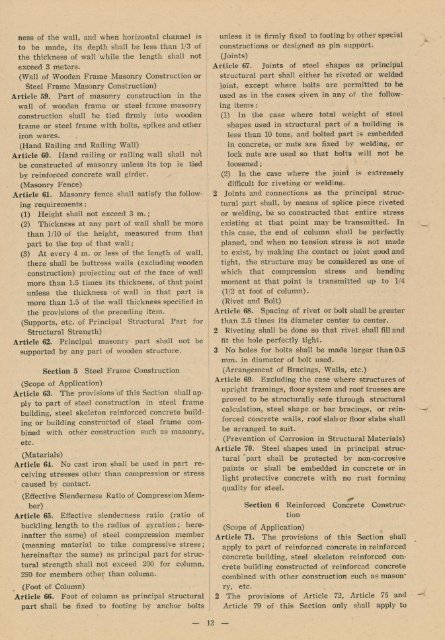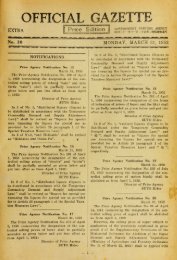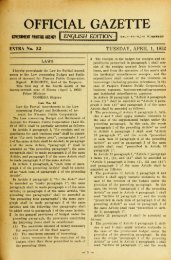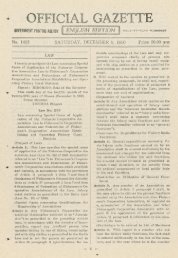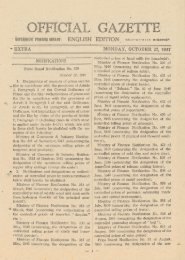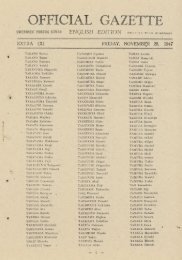OFFICIAL GAZETTE
OFFICIAL GAZETTE
OFFICIAL GAZETTE
Create successful ePaper yourself
Turn your PDF publications into a flip-book with our unique Google optimized e-Paper software.
ness of the wall, and when horizontal channel is<br />
to be made, its depth shall bs less than 1/3 of<br />
the thickness of wall while the length shall not<br />
exceed 3 meters.<br />
(Wall of Wooden Frame Masonry Construction or<br />
Steel Frame Masonry Construction)<br />
Article 59. Part of masonry construction in the j<br />
wall of wooden frame or steel frame masonry<br />
construction shall be tied firmly into wooden<br />
frame or steel frame with bolts, spikes and other<br />
iron wares.<br />
(Hand Railing and Railing Wall)<br />
Article 60. Hand railing or railing wall shall no*t<br />
be constructed ©f masonry unless its top is tied<br />
by reinforced concrete wall girder.<br />
(Masonry Fence)<br />
Article 61. Masonry fence shall satisfy the following<br />
requirements :<br />
(1) Height shall not exceed 3 m.;<br />
(2) Thickness at any part of wall shall be more<br />
than 1/10 of the height, measured from that<br />
part to the top of that wall;<br />
(3) At every 4 m. or less of the length of wall,<br />
there shall be buttress walls (excluding wooden<br />
construction) projecting out of the face of wall<br />
more than 1.5 times its thickness, of that point<br />
unless the thickness of wall in that part is<br />
more than 1.5 of the wall thickness specified in<br />
the provisions of the preceding item.<br />
(Supports, etc. of Principal Structural Part for<br />
Structural Strength)<br />
Article 62. Principal masonry part shall not be<br />
supported by any part of wooden structure.<br />
Section 5 Steel Frame Construction<br />
(Scope of Application)<br />
Article 63. The provisions of this Section shall apply<br />
to part of steel construction in steel frame<br />
building, steel skeleton reinforced concrete building<br />
or building constructed of steel frame combined<br />
with other construction such as masonry,<br />
etc.<br />
(Materials)<br />
Article 64. No cast iron shall be used in part receiving<br />
stresses other than compression or stress<br />
caused by contact.<br />
(Effective Slenderness Ratio of Compression Member)<br />
Article 65. Effective slenderness ratio (ratio of<br />
buckling,length to the radius of gyration; hereinafter<br />
the same) of steel compression member<br />
(meaning material to take compressive stress;<br />
hereinafter the same) as principal part for structural<br />
strength shall not exceed 200 for column,<br />
250 for members other than column.<br />
(Foot of Column)<br />
Article 66. Foot of column as principal structural<br />
part shall be fixed to footing by anchor bolts<br />
-12-<br />
unless it is firmly fixed to footing by other special<br />
constructions or designed as pin support.<br />
(Joints)<br />
Article 67. Joints of steel shapes as principal<br />
structural part shall either be riveted or welded<br />
joint, except where bolts are permitted to be<br />
used as in the cases given in any of the follow-<br />
I<br />
I<br />
j<br />
i<br />
ing items:<br />
(1) In the case where total weight of steel<br />
shapes used in structural part of a building is<br />
less than 10 tons, and bolted part is embedded<br />
in concrete, or nuts are fixed by welding, or<br />
lock nuts are used so that bolts will not be<br />
loosened ;<br />
(2) In the case where the joint is extremely<br />
difficult for riveting or welding.<br />
2 Joints and connections as the principal structural<br />
part shall, by means of splice piece riveted<br />
or welding, be so constructed that entire stress<br />
existing at that point may be transmitted. In<br />
this case, the end of column shall be perfectly<br />
planed, and when no tension stress is not made<br />
to exist, by making the contact or joint good and<br />
tight, the structure may be considered as one of<br />
which that compression stress and bending<br />
moment at that point is transmitted up to 1/4<br />
(1/2 at foot of column).<br />
(Rivet and Bolt)<br />
Article 68. Spacing of rivet or bolt shallbe greater<br />
than 2.5 times its diameter center to center.<br />
2 Riveting shall be done so that rivet shall filland<br />
fit the hole perfectly tight.<br />
3 No holes for bolts shall be made larger than0.5<br />
mm.in diameter of bolt used.<br />
(Arrangement of Bracings, Walls, etc.)<br />
Article 69. Excluding the case where structures of<br />
upright framings, floor system and roof trusses are<br />
proved to be structurally safe through structural<br />
calculation, steel shape or bar bracings, or rein-<br />
forced concrete walls, roofslabor floor slabs shall<br />
be arranged to suit.<br />
(Prevention of Corrosion in Structural Materials)<br />
Article 70. Steel shapes used in principal structural<br />
"part shall be protected by non-corrosive<br />
paints or shall be embedded in concrete or in<br />
light protective concrete with no rust forming<br />
quality for steel.<br />
Section 6 Reinforced Concrete Construction<br />
(Scope of Application)<br />
Article 71. The provisions of this Section shall<br />
apply to part of reinforced concrete in reinforced<br />
concrete building, steel skeleton reinforced concrete<br />
building constructed of reinforced concrete<br />
combined with other construction such as mason"<br />
ry, etc.<br />
2 The provisions of Article 72, Article 75 and<br />
Article 79 of this Section only shall apply to


